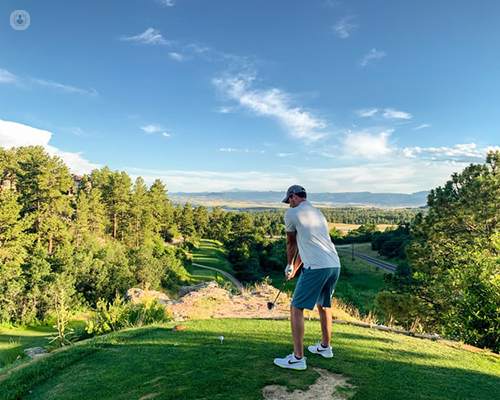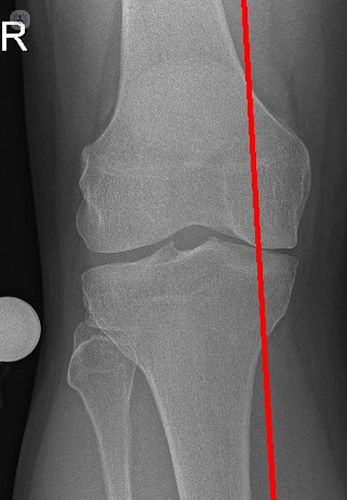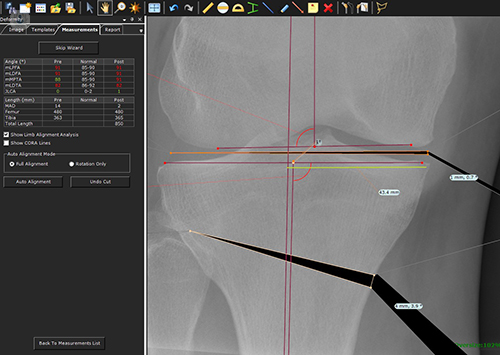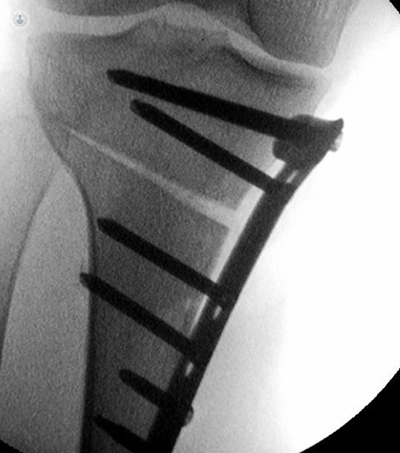Knee osteotomy: can I choose it over replacement surgery?
Escrito por:If you live with knee arthritis and have been doing your research into treatment options, you may have discovered that a knee osteotomy (or preservation surgery) is an alternative to a knee joint replacement. We spoke to one of our expert orthopaedic surgeons Mr David Elson about an osteotomy, who is suitable for the revolutionary procedure and how it compares to the more traditional knee replacement surgery.

When is a knee osteotomy recommended?
A knee osteotomy may be recommended in the early stages of arthritis when patients have moderate to severe pain, which is proving difficult to manage with conservative measures. Usually, this is offered to patients who have some degree of deformity in their leg either being bow-legged (varus) or knock-kneed (valgus).
Typically, osteotomy patients may be slightly younger and more active than those having knee replacement but there are no hard and fast rules because each patient is assessed as an individual.
How is knee osteotomy performed?
Osteotomy around the knee involves the surgeon cutting almost all the way across the bone. This is then hinged open or closed to change the shape of the leg. The bone is held in the new position with a metal plate and screws until it heals in the new shape. This is done to shift the weight distribution across the knee and offload the painful or damaged part of the knee.
Here is an example case on the tibia.
The weight-bearing axis (red line) runs through the medial compartment of the knee, where the patient has early arthritis:

Here is the surgical plan before the operation:

Here is the cut made in the tibia with a plate to hold the gap open:

This is the corrected weight-bearing axis, shifting the patients' weight-bearing away from the damaged part of the knee:

What are the advantages of a knee osteotomy over total/partial replacement surgery?
The good news about an osteotomy is that you get to keep your native knee joint. For younger patients, this may be very appealing if you don’t want to lose the biological function of your knee joint. Knee replacements are designed for more sedentary activity and accordingly, you may be more active once you have recovered from a knee osteotomy.
What are the key differences between both procedures?
You keep your own knee with knee osteotomy but the shape of your leg is changed to achieve a reduction in your pain levels.
With a total or partial knee replacement, the damaged part of your knee is removed and replaced with metal and plastic implants. This can be very effective too, but it is impossible to go back once you have committed to a joint replacement.
Will a knee osteotomy mean I won't need a knee replacement ever/for a long time?
Potentially, a good knee osteotomy may mean that you avoid the need for knee replacement altogether, but inevitably that will be influenced by your symptomatic response. A review paper published in 2013; assimilated 25 papers from the literature to give knee osteotomy survival rates of 90% at 5 years, 77% at 10 years and 71% at 15 years.
So there is a 7 out of 10 chance that a knee osteotomy would allow you to avoid knee replacement for up to 15 years. One of the aims of the United Kingdom Knee Osteotomy Registry (UKKOR) is to establish long term survivorship rates in the UK.
What should patients ensure they discuss with their surgeon regarding knee osteotomy?
It’s important that patients discuss their expectations with the surgeon to ensure that these can be met. If you are working at the time of your surgery then the surgeon will need to understand what it is that you expect to be able to do afterwards in order to judge how long you are likely to need off work recovering from the surgery. In office-based jobs, you may be back to function about six weeks after a knee osteotomy but this can take longer if you are (three months) in heavier manual work.
Book an appointment with Mr Elson now via his Top Doctor’s profile. Can’t visit in person? Mr Elson is available for a video call using our e-Consultation tool, which can also be found on his profile.


